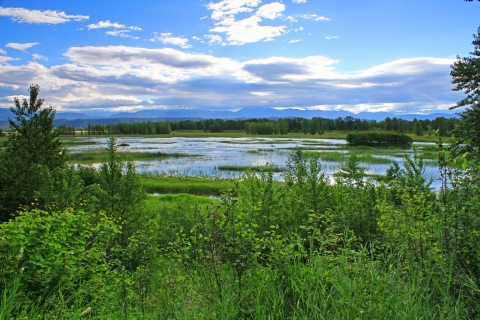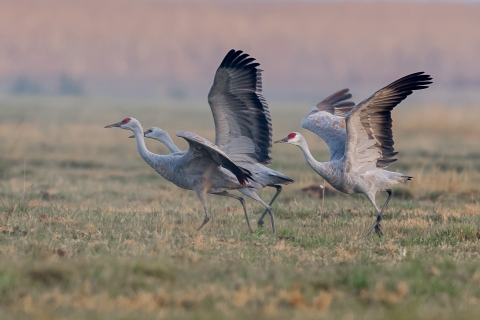While birding at Kootenai National Wildlife Refuge in North Idaho, you can see so. Many. Birds. Number four on the Idaho Birding Trail list for North Idaho, at peak times during the fall migration you can see 40,000 waterfowl at once on the refuge. In the summer, black tern and red-necked grebe come to the refuge to breed and raise the next generation. Resident, breeding land birds such as least flycatcher, red-eyed vireo, American redstart, Bullock’s oriole, and bank swallow are often visible along Deep Creek Trail.
Hundreds of species rely on the refuge as a safe place to rest, feed, or even raise their young. But for the first time, refuge staff and local birders witnessed sandhill cranes successfully raise their young on the refuge. “It’s been exciting! Lots of visitors and birders have been coming to visit the family. Watching these chicks grow and fledge – successful nesting is not something that’s happened in the area before to anyone’s knowledge,” said Refuge Manager Shannon Ehlers.
Standing four feet tall with a wingspan of six feet, sandhill cranes are an amazing sight. ! Watching them stalk through open, grassy meadows hunting for a meal, their rusty call rattling through the air – it reminds you that these feathered giants are the descendants of dinosaurs! (Note: Birds are descended from small theropods. These are the same type of dinosaurs as T. Rex – but smaller. Rawr!) As opportunistic omnivores, sandhill cranes eat whatever is available. This includes plants, grains, invertebrates, small lizards, snakes, frogs, and even mice! Migrating to breeding sites each spring, sandhill cranes prefer freshwater wetlands for foraging, breeding, and nesting. They spend most of their lives in wetlands, marshes, wet grasslands, and river basins.
In 2022, the refuge completed a habitat restoration project that improved the water delivery infrastructure and removed the old and leaking levy and water structures and removed invasive species invasive species
An invasive species is any plant or animal that has spread or been introduced into a new area where they are, or could, cause harm to the environment, economy, or human, animal, or plant health. Their unwelcome presence can destroy ecosystems and cost millions of dollars.
Learn more about invasive species . Once the site of a deep, stagnant pond, the area is now a healthy, connected wetland habitat where native plants can flourish - increasing the amount of plant seeds and invertebrates available for wildlife to eat. At the refuge, the cranes can be found in the restored wetland and wet meadow areas near their nest site on the southern end of the property.
“Seeing sandhill cranes here, using the restored habitat, just reinforces how important these projects are for wildlife,” said Ehlers. The refuge is planning additional habitat restoration projects to remove old levees and improve water connectivity and management capabilities to improve habitat for waterfowl, birds, moose, and a host of other species.
Some of the funding for this successful project came from the Great American Outdoor Act, which is part of the Biden administration’s America the Beautiful initiative, a decade-long campaign to conserve, connect and restore 30% of our country’s lands and waters by 2030. Locally led and voluntary conservation work across public, private, and Tribal lands and waters are helping reduce maintenance backlogs and to ensure visitors are safe and comfortable on public lands.
The 2,774-acre refuge in Idaho’s Panhandle is approximately 20 miles south of the Canadian border and five miles west of Bonner’s Ferry. The lush wetlands stretch up into the forested foothills of the Selkirk Mountains, visitors can hike, hunt, fish, photograph and observe wildlife at the refuge. Established in 1964 for migratory waterfowl and in addition to the 220 species of birds that rely on this important habitat, visitors can find 45 species of mammals and 22 species of fish on the refuge.
“We get thousands of visitors who come to the refuge to experience the auto tour or hike and see the amazing wildlife, which these days, thanks to the habitat restoration project, now includes breeding and nesting sandhill cranes,” said Ehlers.
Grays Lake National Wildlife Refuge in southern Idaho is one of the world’s largest gatherings of breeding sandhill cranes. The birds gather en masse for the safety in numbers, but also to meet or return to their mate. Once a crane finds their match, they stay together for life.
“Because there are not large numbers of cranes in northern Idaho, they don’t have that same protection from predators the large group provides, it’s likely one of the reasons we haven’t seen successful nests off the refuge,” said Ehlers.
Staff and local birders first spotted the breeding pair in late spring. Around June, the parents were spotted with two babies – called colts rather than chicks. One look at their long, long legs and you can understand the name! It takes about a month for an egg to hatch and it can be more than two months before the colts are no longer dependent on their parents for food. Throughout the summer, the parents have been spending time with the chicks and teaching them to forage and hunt in the freshly disced refuge meadows.
At the beginning of August, the colts were seen flying with their parents – the first successfully fledged chicks taking the next steps in life, growing up and preparing to migrate with their parents. Hopefully the colts will return to the refuge one day to raise their own chicks.







